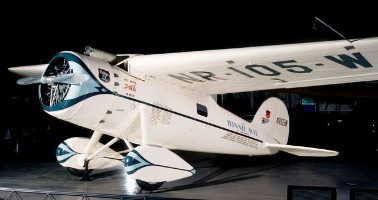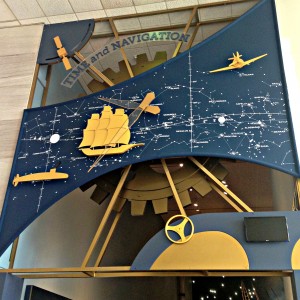A Brief Tour of Time (and Navigation)
A new exhibit at the National Air and Space Museum tells us where we are, and how to get where we’re going next
![]()
You’re going to need a clock. That’s what the National Air and Space Museum wants to get across to visitors with its new permanent exhibit, Time and Navigation, opening tomorrow.
“If you want to know where you are, or if you want to know where you’re going, you need a reliable clock,” said Carlene Stephens, a curator at the National Museum of American History, which houses the Smithsonian’s collection of clocks and contributed to the exhibit. Appropriately, visitors enter the exhibit by walking under a beautiful blue and gold clock, in the “spirit of the early and truly magnificent European clocks,” says exhibit designer Heidi Eitel. She wanted to include the automaton clock that comes to life every quarter hour to tell “the story of when people began sharing time.”
The exhibit takes you through three eras, starting with Navigating at Sea, when sailors first used sextants and star charts to find their way across vast oceans. Though ships have had navigators since the 1600s, it wasn’t until the early 1800s that they had marine chronometers that kept reliable time at sea and allowed navigation with any precision. Galileo’s pendulum clock and an interactive 19th-century ship’s sextant that lets visitors navigate by the stars are highlights.
Next, the exhibit takes flight. Even aviation heros like Charles Lindbergh got lost before Navy Lieutenant Commander P.V.H. Weems developed air navigation techniques. Overhead, visitors can see the Lockheed Vega Winnie Mae, which Wiley Post and famed navigator Harold Gatty flew around the world in 1931 in just eight days — a feat that could not have been accomplished without precise location-determining skills.

The Lockheed Vega "Winnie Mae," now on display in the Time and Navigation exhibit, was flown around the world in 1931 in just eight days. Photo by Dane Penland, National Air and Space Museum
In the third and final era, navigation gets three-dimensional as it moves into space. Throughout this section of the exhibit are star charts where Earth becomes just another potential destination on the map. Our education on space navigation starts with the story of NASA’s nine Ranger spacecraft, notorious for their failures to reach the moon, including two that completely missed the mark. But astronauts eventually made it to the surface, and visitors can see the Apollo sextant and space shuttle star tracker here. “When we go back into deep space,” said curator Andrew Johnston, “it’ll be very interesting to see how far we’ve come with navigation.” With the technology available today, the exhibit explains, spacecraft missions in 2012 were 100,000 times more accurate than they were in the 1960s.
Finally, the exhibit shows us how we navigate today. Atomic clocks (one is on view in case you need to set your watch) that keep time to three billionths of a second, GPS satellites that can be accessed from anywhere in the world, and smartphones that crunch all sorts of data have replaced chronometers and sextants and bulky books of charts. In fact, navigation today doesn’t even need people: Stanford’s driverless-car Stanley is also on display. It won DARPA’s 2005 Grand Challenge by navigating an off-road 132-mile race. But proving its necessity in our everyday modern lives, Time and Navigation ends with stories from today — a farmer, a fireman and a student explain how their livelihoods are affected by the technology developed since the first sailor located the North Star.
